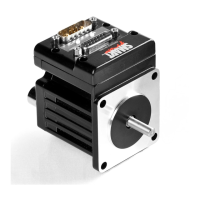Moog Animatics SmartMotor™ Developer's Guide,Rev. L
Page 776 of 909
VC
Velocity Commanded
APPLICATION: Motion control
DESCRIPTION: Gets (reads) the commanded velocity
EXECUTION: Immediate
CONDITIONAL TO: N/A
LIMITATIONS: N/A
REPORT VALUE: RVC
WRITE: Read only
LANGUAGE ACCESS: Formulas and conditional testing
UNITS: (encoder counts / sample) * 65536
RANGE OF VALUES: -2147483648 to 2147483647
TYPICAL VALUES: -3200000 to 3200000
DEFAULT VALUE: 0
FIRMWARE VERSION: 5.x and later
COMBITRONIC: RVC:3, x=VC:3
where ":3" is the motor address — use the actual address or a
variable
DETAILED DESCRIPTION:
When a velocity or position profile move is commanded, the velocity is ramped up and down
according to the settings of ADT=, AT=, or DT=, with the value of VT as the maximum value.
At any one instant, the calculated velocity of the motion profile can be reported. The sign of
this reported velocity is dependent on the direction. A velocity in the negative direction will be
reported negative by this command, while a positive velocity is reported as a positive value.
The VC command gets (reads) the commanded velocity as follows:
l =VC
Reads the real-time commanded velocity combined from all trajectory generators.
NOTE: It is not the actual velocity (VA); it is the velocity calculated by the velocity
profile at the time the VC command is executed.
Equations for Real-World Units:
Because the encoder resolution and sample rate can vary, the following general equations can
be applied to converting the value of VC to various units of velocity. These equations force
floating-point calculations to avoid overflow and maintain resolution. They can be placed in a
user program, or they can be precalculated if the values of SAMP and RES are known (SAMP
and RES can be reported from the terminal using the RSAMP and RRES commands,
respectively). SAMP can change if the PID command is used. The value of REScan differ
between motor models.
Part 2: Commands: VC

